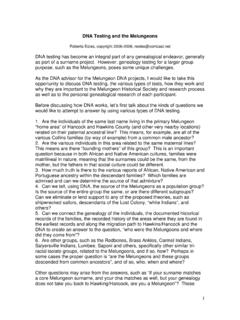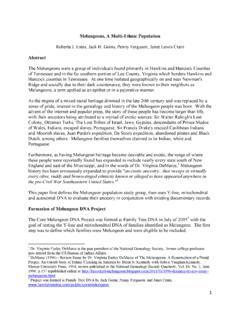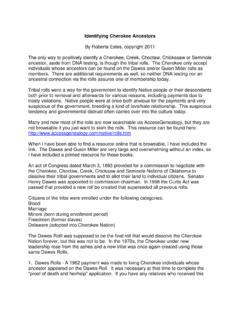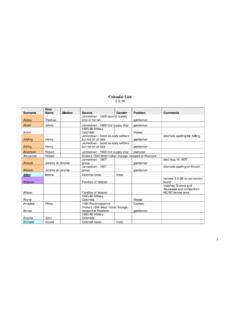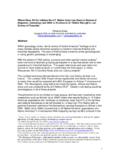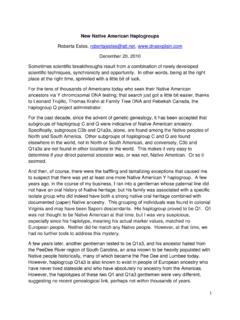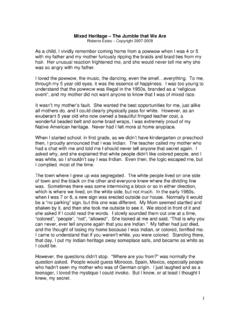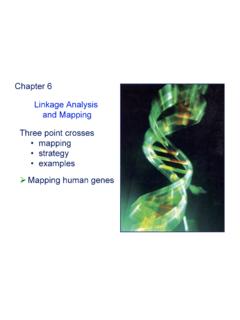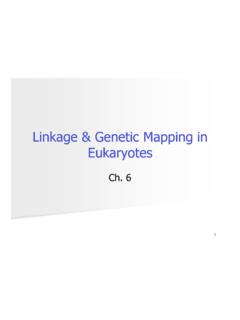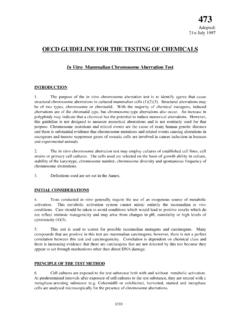Transcription of Revealing American Indian and Minority Heritage …
1 Journal of Genetic Genealogy, 6(1), 2010 Journal of Genetic Genealogy - 1 Fall 2010, Vol. 6, Number 1 Revealing American Indian and Minority Heritage using Y-line, Mitochondrial, Autosomal and X Chromosomal Testing Data Combined with Pedigree analysis Roberta Estes Abstract As a project administrator of several historically based genetic genealogy projects, such as the Lost Colony, Cumberland Gap, Melungeon, Carolina Native Heritage and Hatteras Island projects which involve thousands of participants, I routinely receive questions from individuals who have an oral history of Native American Heritage and would like to use genetic genealogical tools to prove, or disprove, their oral history.
2 This paper documents the various discovery steps and processes using different types of DNA testing for a typical individual participant and appropriate family members who carry an oral Native history combined with genealogical evidence that has been forthcoming during the elapsed years since genetic testing for genealogy first because available. Each test along with associated benefits and detriments are discussed in relation to the analysis of Minority ancestry. The conclusion combines the information from all the various tests, pedigree analysis and genealogical evidence, discussing which tests are beneficial and most accurate, and which ones are not useful, and why.
3 Oral History Oral history is an important component of genealogical research. For most people, it's where they begin their search. I ve been working with oral history for many years in relation to the various projects I administer, genealogy and my clients. I ve discovered that oral history tends to be relatively accurate for 2-3 generations. After that, parts of the story are preserved, but the generations, individuals and timeline are often askew. For example, most people know their grandparents, but generally don t know their great-grandparents, so the stories of their great-grandparents generation are conveyed second hand through either their parents or their grandparents.
4 Memories fail people, and the essence of the story about Indian ancestry may be accurate, but who and in which generation may have been forgotten or only partially remembered. With each ensuing generation, more detail is lost until only the primary topic itself is remembered Address for correspondence: Roberta Estes, or Received: Dec. 24, 2009; Accepted: July 17, 2010; Published Dec. 19, 2010 Open Access article distributed under Creative Commons License Attribution License ( ) which permits noncommercial sharing, reproduction, distribution, and adaptation provided there is proper attribution and that all derivative works are subject to the same license.
5 Accurately, that the family has Indian ancestry. In the hundreds of people I have worked with, I have yet to find one person whose ancestor that they thought was full blooded Indian actually was Native as proven by either DNA or traditional genealogy. Needless to say, people are often very disappointed. DNA is often our only path to unravel the truth, as Indian ancestry was hidden in the 1800s and early 1900s due to laws that labeled anyone with Indian Heritage as a person of color , meaning black or more accurately stated, not white.
6 Along with that label came the discriminatory practices of that time1. Native American History Many American families carry oral histories of Native American Heritage . Most often, we think of either the Western tribes who still reside in or near their indigenous homes, or the Cherokee who were displaced in the 1830s, forced to march from Appalachia to Oklahoma in the dead of winter, an event subsequently known as the Trail of Tears2. In truth, the history of Native American Heritage in North America is much, much more complex.
7 It is probable that many of the people who carry oral history of 1 2 Estes, Revealing American Indian and Minority Heritage using Y-line, Mitochondrial, Autosomal and X Chromosomal Testing Data Combined with Pedigree analysis , J. Gen. Geneal 2010, 6(1) Journal of Genetic Genealogy - 2 Fall 2010, Vol. 6, Number 1 Cherokee Heritage are actually descended from a tribe other than the Cherokee, at least initially. The Cherokee were well known for accepting remnants of other tribes whose members and numbers had been decimated by disease or war.
8 Sometimes alliances were created for mutual protection or benefit. The Cherokees were not the only tribe in the Eastern United States. The Eastern seaboard was widely populated by varying tribes, some related and affiliated, and some not. There were in fact three major language groupings, Algonquin, Souian and Iroquoian scattered throughout the Eastern seaboard northward into Canada, westward to Appalachia and south to the Gulf of Mexico3. People from Africa were also imported very early, often, but not always, as slaves.
9 Jamestown shows evidence of individuals of African Heritage as early as 1619. Those who were later brought specifically as slaves sometimes ran away, escaping into the Native population. Conversely, eastern seaboard indians were often taken or sold by defeating tribes as well as colonists and traders into slavery4. In the early years of settlement, European women were scarce. Some men immigrated with wives and families, but most did not, and few women came alone.
10 Therefore, with nature taking its course, it is not unreasonable to surmise that many of the early settlers traded with, worked alongside and married into indigenous families, especially immigrants who were not wealthy. Wealthy individuals traveled back and forth across the Atlantic and could bring a bride on a subsequent journey. What does this mean to the family historian who is trying to prove their genealogy and understand better just who they are and where they come from?
